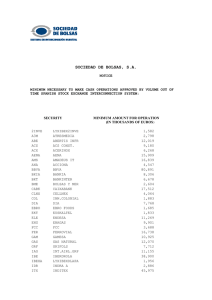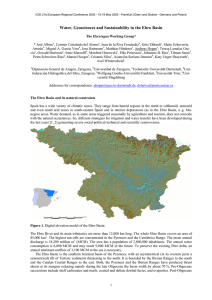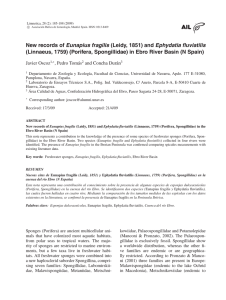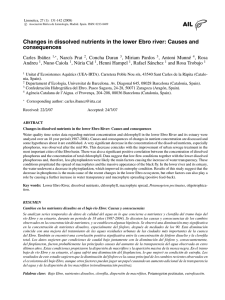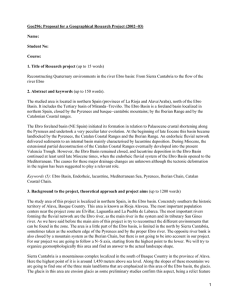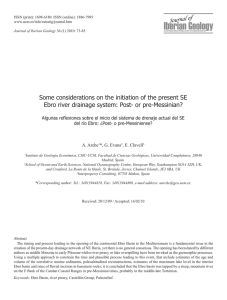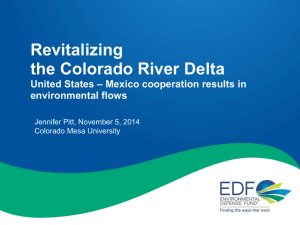Coastal changes in the Ebro delta: Natural and human factors
Anuncio
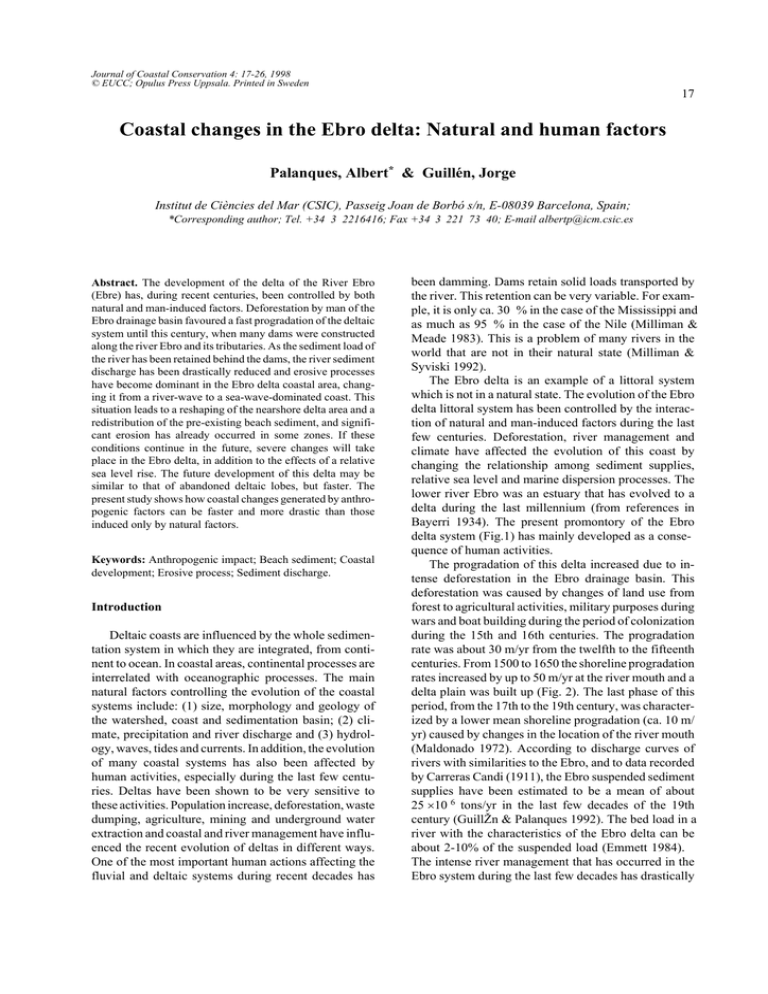
Journal of Coastal Conservation 4: 17-26, 1998 © EUCC; Opulus Press Uppsala. Printed in Sweden - Coastal changes in the Ebro delta - 17 Coastal changes in the Ebro delta: Natural and human factors Palanques, Albert* & Guillén, Jorge Institut de Ciències del Mar (CSIC), Passeig Joan de Borbó s/n, E-08039 Barcelona, Spain; *Corresponding author; Tel. +34 3 2216416; Fax +34 3 221 73 40; E-mail [email protected] Abstract. The development of the delta of the River Ebro (Ebre) has, during recent centuries, been controlled by both natural and man-induced factors. Deforestation by man of the Ebro drainage basin favoured a fast progradation of the deltaic system until this century, when many dams were constructed along the river Ebro and its tributaries. As the sediment load of the river has been retained behind the dams, the river sediment discharge has been drastically reduced and erosive processes have become dominant in the Ebro delta coastal area, changing it from a river-wave to a sea-wave-dominated coast. This situation leads to a reshaping of the nearshore delta area and a redistribution of the pre-existing beach sediment, and significant erosion has already occurred in some zones. If these conditions continue in the future, severe changes will take place in the Ebro delta, in addition to the effects of a relative sea level rise. The future development of this delta may be similar to that of abandoned deltaic lobes, but faster. The present study shows how coastal changes generated by anthropogenic factors can be faster and more drastic than those induced only by natural factors. Keywords: Anthropogenic impact; Beach sediment; Coastal development; Erosive process; Sediment discharge. Introduction Deltaic coasts are influenced by the whole sedimentation system in which they are integrated, from continent to ocean. In coastal areas, continental processes are interrelated with oceanographic processes. The main natural factors controlling the evolution of the coastal systems include: (1) size, morphology and geology of the watershed, coast and sedimentation basin; (2) climate, precipitation and river discharge and (3) hydrology, waves, tides and currents. In addition, the evolution of many coastal systems has also been affected by human activities, especially during the last few centuries. Deltas have been shown to be very sensitive to these activities. Population increase, deforestation, waste dumping, agriculture, mining and underground water extraction and coastal and river management have influenced the recent evolution of deltas in different ways. One of the most important human actions affecting the fluvial and deltaic systems during recent decades has been damming. Dams retain solid loads transported by the river. This retention can be very variable. For example, it is only ca. 30 % in the case of the Mississippi and as much as 95 % in the case of the Nile (Milliman & Meade 1983). This is a problem of many rivers in the world that are not in their natural state (Milliman & Syviski 1992). The Ebro delta is an example of a littoral system which is not in a natural state. The evolution of the Ebro delta littoral system has been controlled by the interaction of natural and man-induced factors during the last few centuries. Deforestation, river management and climate have affected the evolution of this coast by changing the relationship among sediment supplies, relative sea level and marine dispersion processes. The lower river Ebro was an estuary that has evolved to a delta during the last millennium (from references in Bayerri 1934). The present promontory of the Ebro delta system (Fig.1) has mainly developed as a consequence of human activities. The progradation of this delta increased due to intense deforestation in the Ebro drainage basin. This deforestation was caused by changes of land use from forest to agricultural activities, military purposes during wars and boat building during the period of colonization during the 15th and 16th centuries. The progradation rate was about 30 m/yr from the twelfth to the fifteenth centuries. From 1500 to 1650 the shoreline progradation rates increased by up to 50 m/yr at the river mouth and a delta plain was built up (Fig. 2). The last phase of this period, from the 17th to the 19th century, was characterized by a lower mean shoreline progradation (ca. 10 m/ yr) caused by changes in the location of the river mouth (Maldonado 1972). According to discharge curves of rivers with similarities to the Ebro, and to data recorded by Carreras Candi (1911), the Ebro suspended sediment supplies have been estimated to be a mean of about 25 ×10 6 tons/yr in the last few decades of the 19th century (GuillŽn & Palanques 1992). The bed load in a river with the characteristics of the Ebro delta can be about 2-10% of the suspended load (Emmett 1984). The intense river management that has occurred in the Ebro system during the last few decades has drastically 18 Palanques, A. & Guillén, J. Fig. 1. Map of the Ebro delta. Numbered points represent the locations from which the data shown in Figs. 5 and 7 were obtained. changed the sediment discharge and the deltaic construction. The present study deals with the situation that coastal changes generated by anthropogenic factors can be faster and more drastic than those induced only by natural factors. River management during the last century The main type of river management during this century has been dam construction (Fig. 3). Between 1906 and 1930 some significant dams (200 hm3) were built in the upper part of the river Segre and several small capacity reservoirs (0.3-28 hm 3) were also built in some of the tributaries of the Ebro. The mean amount of suspended sediment transported by the river decreased to 17 ×10 6 tons/yr in 1911 and to 14 ×10 6 tons/yr in 1935. A larger reservoir, the Ebro dam (540 hm3), was constructed in the upper part of the river in the 1940s. During the 1940s and 1950s several reservoirs with capacities ranging from 50 to 200 hm3 were also constructed. In 1959 another important dam, the Yesa Dam (470 hm3), was located in the upper part of the River Fig. 2. Morphological evolution of the lower Ebro river and the Ebro delta plain during the last five centuries based on historical charts from Maldonado (1972) and Call’s et al. (1988). - Coastal changes in the Ebro delta - 19 Fig. 3. Drainage basin of the river Ebro and location of the main dams and physiographic elements. Arag—n (one of the most important tributaries of the Ebro). Most of these dams were located in the mountainous areas of the upper course of the river and tributaries, where sediment transport is more energetic. Accumulative retention of these dams decreased the river sediment load beyond them very significantly, and the sediment load reaching the lower Ebro course was already very low even before the construction of dams in this zone. At the beginning of the 1960s, the amount of suspended sediment discharged by the river was only 2.2 ×10 6 tons/yr. In 1966 the largest dam of the Ebro system, the Mequinenza Dam (> 1000 hm3), was built in the lower part of the river. In 1968 another important dam was constructed in the River Cinca, the Mediano Dam, whose capacity is 436 hm3. In 1969 the Ribarroja Dam (136 hm3) was built a few km downstream of the Mequinenza dam. These dams retain sediment load Table 1. Year of construction of the main dams, capacity (C) and sediment discharge (SD) during the last century. Year Dam C SD (hm3) (t/yr ×10 6) 1880 1906-1930 1911 1934 1940-1950 1946 1959 1962 1966 1968 1969 1983-1986 1988-1990 25 several 0.3-200 17 14 several 50-200 Ebro 540 Yesa 470 Ñ 2.2 Mequinenza 1000 Mediano 436 Ribarroja 136 Ñ 0.15 Ñ 0.12 Source Gorria (1880)* Carreras (1911)* Bayerri (1934-35) Catal‡n (1969) Palanques (1987) GuillŽn & Palanques (1992) from more than 95% of the drainage basin. During the 1980s, the Ebro only discharged between 0.12 ×106 and 0.2 ×106 tons/yr of suspended sediment to the sea (Fig. 4) (Table 1). At present the Ebro discharges into the sea are less than 1% of the sediment discharged before the construction of the dams. The accumulative sediment retention in each of the dams built along the Ebro and its tributaries and the location of dams in the lower river course are the main factors producing this huge reduction in river sediment discharge. Dams have also helped to regulate river water discharge and to mitigate river floods. Floods of more than 3000 m3/s took place before the construction of the dams. During these floods, the river could transport huge amounts of sediment to the sea (more than 106 tons/d). However, after the regulation of water discharge induced by the dams, these highsediment discharge events have ceased to occur. During this century there has also been a general trend of decreasing mean annual water discharge with some stages of high water discharge in 1915 and 1960. The river water discharge has decreased from mean values of 550 m3/s during the 1914-1935 period to 385 m 3/s for the last 20 yr. The decreasing trend in the annual water discharge has been continuous from 1960 to the present. The lowest discharges took place mainly during the eighties. In 1982, 1986, 1987 and 1989 the annual mean was less than 250 m3/s. The monthly water discharge of the Ebro is irregular. During the first few decades of this century the highest mean monthly discharges were in winter and spring with a mean of 900m 3/s, and the lowest discharges were in summer with a mean of 200 m3/s. At mid-century these values had decreased to 800 and 20 Palanques, A. & Guillén, J. Table 2. Concentrations of different contaminants in sediment (*) and suspended sediment (**) measured in the lower River Ebro. Contaminants Concentration Source Total hydrocarbons lin C14-C24 lin C25-C39 PCBs ppÕ-DDT Zn Cr Cu 2.7 mg/g * 1.0 mg/g * 1.7 mg/g * 17-61 ng/g * 5.3-14.5 ng/g * 230-290 mg/g ** 280-300 mg/g ** 80-94 mg/g ** Grimalt & Albaiges (1986) Grimalt & Albaiges (1986) Grimalt & Albaiges (1986) Tolosa et al. (1997) Ballester et al. (1986) Palanques et al. (1990) Palanques et al. (1990) Palanques et al. (1990) 100m 3/s respectively. During the last few decades the maximum mean monthly discharges hardly reached 500 m3/s, and there were dry periods longer than one year during which water discharge ranged between 50 and 250 m3/s (GuillŽn 1992). This decreasing trend in mean water discharge can be attributed to the human management of the river water. The lower water discharge contributes to the reduction in the river sediment discharge and, along with the extraction of ground water, may have contributed to the increase in the salt ground water intrusion and to the decrease in nutrients supplied to the Ebro continental shelf. Although the nutrient concentration is increasing in the lagoons of the delta plain due to agricultural activities (ForŽs 1989; Comin et al. 1989), the total amount of nutrients discharged into the sea could have decreased as a consequence of the decrease in the total volume of freshwater discharged into the sea. Another effect of manÕs activities is the chemical pollution of the aquatic environment. Water contamination reached high levels during the last century when domestic and industrial use of water increased and chemicals began to be used in agriculture. Urban, industrial and agricultural wastes are incorporated in the fluvial system which transports these substances along its course. Some pollutants, such as heavy metals, are retained in the dams, which helps to reduce the heavy metal contamination in the lower Ebro (Manrique et al. 1986). However, in spite of this retention, suspended sediment from this part of the river is significantly contaminated by cadmium, chromium, copper and zinc (Palanques et al. 1990). In addition, the lower Ebro is also relatively highly contaminated with certain types of pesticides from agricultural activities in the delta (Ballester et al. 1986) and also by hydrocarbons (Grimalt & Albaiges 1986) and PCBs (Tolosa et al. 1997) (Table 2). The present situation of the lower Ebro The lower part of the Ebro is a microtidal salt wedge estuary (GuillŽn & Palanques 1992; Iba–ez et al. 1997b). The intrusion of the salt wedge is mainly regulated by the water discharge and the morphology of the river bed and the river mouth. Salt wedge intrusion usually occurs when the river water discharge is lower than 400 m3/s. Usually, the head of the salt wedge is ca. 14 km upstream in a topographic elevation (Gracia Island) when the river discharge is between about 150 and 400 m3/s. With lower water discharges the salt wedge can intrude more than 25 km upstream, beyond the city of Amposta. Fig. 4. Annual water and sediment discharge of the River Ebro during the 20th century (from GuillŽn & Palanques 1992). - Coastal changes in the Ebro delta At present, the water discharge in the lower part of the river is regulated by the last downstream dam, which is required to deliver a minimum discharge of about 150 m3/s for the necessities of a nuclear power station located some km downstream. Near the delta, up to 50 m3/s of water can be taken from the river when the two main irrigation channels of the delta are opened (Camp & Delgado 1987). Therefore, a water discharge of about 150-200m 3/s is maintained in the lower part of the river during dry periods when possible. This regulation of the water discharge helps to stabilize the salt wedge position around Gracia Island in dry periods. Prior to the construction of dams, high and low water discharge were more extreme and the salt wedge may have intruded longer distances upstream and may also have been pushed out of the river more often than nowadays. With salt wedge intrusion, the flow section of the surface freshwater layer decreases downstream, causing an increase in the velocity in this layer. When the salt wedge is ca.14 km upstream at Gracia Island, the freshwater layer near the river mouth is only ca. 1.5-2.5 m thick, with currents of up to 80 cm/s. Because of the present river management, this situation is maintained in the river mouth for longer periods of time, without receiving new sediment supplies. This causes the erosion of the lower river banks and an aggradational trend of the river mouth that favours the development of the system back again towards an estuary. Of the sediment discharged by the Ebro, only the sand fraction contributes to the nearshore dynamics. Assuming that the bed load of the Ebro in natural conditions could be 2-10% of the suspended load (Emmett 1984), this river was able to discharge about 1-2 ×10 6 tons/yr of sand before the construction of 21 dams.During the present conditions, the sand supplies to the Ebro coast have been estimated at about 50000 tons/yr (GuillŽn et al. 1992). Short-term changes in the amount of sand supplied by the Ebro are related to water discharge variations. Sand transport in the lower Ebro only occurs when the water discharge is > 400 m3/s, without salt wedge intrusion (GuillŽn et al. 1992). The Ebro delta coast The Ebro delta is a microtidal (<0.3m) storm-wave dominated coast, with a low-period mean wave regime. The most persistent waves in the study area are from eastern (22%) and southeastern (15%) directions (Gracia et al. 1989). Ca. 65% of the waves are sea and the remainder 35% are swell. Wave periods range between 2 and 8 seconds and heights are lower than 4 m for 98% of the time. Maximum wave heights are about 56m from a northeastern direction. The mean offshore significant wave height is 1m and the average mean period is about 3.5 s (Gracia et al. 1989). Resulting long-shore transport rates from the mean wave climate indicate a bidirectional pattern along the Ebro delta coast (GuillŽn 1992) which is shown by the presence of the two spits. Cape Tortosa is the zone of divergence in the transport direction. From Cape Tortosa to the Fangar side, the transport is toward the northwest, increasing in the same direction. From Cape Tortosa to the Banya side the long-shore transport is towards the southwest with maximum values at Cape Tortosa and near to Trabucador Bar. The wave power reaching the beach is controlled by the shore-face bathymetry and the orientation of the shoreline. The wave power magnitude in the northern Fig. 5. General trend of the sediment mean grain size and the shoreline displacement along the Ebro Delta coast during the 1988-1991 period (sample location in Fig.1) (from GuillŽn & JimŽnez 1995). 22 Palanques, A. & Guillén, J. Fig. 7. Sediment mean grain size measured in 1970 and during the 1988-1991 period and resulting trend. Cross-shore distribution of the sediment Fig. 6. The Ebro delta shoreline in 1880 (dashed line) and in 1988 (solid line) (based on Call’s 1988). hemidelta is lower than in the southern one. In the northern hemidelta the wave power increases from the river mouth towards the Fangar spit. In the southern hemidelta the wave power decreases between Cape Tortosa and Eucaliptos Beach, increases to the middle part of Trabucador Bar and decreases southwards (JimŽnez 1996). In general, high wave power corresponds to erosive zones, whereas low wave power indicates deposition zones where the shoreline is currently prograding (Fig. 5) (GuillŽn & JimŽnez 1995). Present behaviour of the Ebro delta coast As a consequence of the drastic decrease in river sediment discharge, the action of marine processes dominates the present evolution of the delta coast. After several centuries of growth, the deltaic evolution trend changed and the present delta became a wave-dominated coast. The drastic decrease in the river sediment discharge has produced a very intense reshaping of the nearshore deltaic area. The central part of the delta has experienced the greatest erosion, with a maximum shoreline retreat of more than 2500m at Cape Tortosa between 1880 and 1990. Trabucador Bar and most of the northern hemidelta are also erosive. The spits experienced much accretion due to the deposition of the eroded material. The southern and northern spits have prograded around 1000 m during the last century (Fig. 6). These changes have been more intense during the last decades. The sediment distribution across the shore face shows an offshore trend towars smaller particles. The mean grain size ranges from 250 µm at the shoreline to less than 125 µm at 6 m water depth. The zone of the shore face shallower than 4 m depth is a high energy zone affected by continuous sediment transport caused by waves. Mean waves could transport coarser material than that available in this high energy zone, which means that there is an excess of wave energy in relation to the available sediment. The deficit of the coarse sediment fractions, which remain trapped upstream behind the dams, could help to generate a disequilibrium between the wave energy and the sediment distribution in the shallowest zone of the shoreface. The deeper zone of the shoreface is a low energy zone where sediment texture is the result of sporadic sand mobility occurring during storm periods and mud deposition during fair weather conditions. Offshore this zone (ca. 11 m water depth), the transition to prodelta mud deposits occurs (GuillŽn & Palanques 1997). Long-shore distribution of the sediment The average mean grain size of the beach-face sediment along the Ebro delta coast ranges from 230 to 275 microns. In general, coarser sediment is present in erosive zones, with high wave power and positive longshore transport gradients (Cape Tortosa, Trabucador Bar and Fangar). Finer sediment is characteristic of depositional areas, with lower power and negative longshore transport gradients (the apices of the two spits and the Eucaliptos beach) (Fig. 5). Southward from the river mouth the sediment characteristics and distribution are the result of the reworking of earlier sediment deposited in the nearshore. The presence of coarser sediment in erosive zones can be associated with the more intense - Coastal changes in the Ebro delta - 23 selective winnowing of the finest fractions and the progressive coarsening of the resulting lag deposit. Erosion areas supply the finer sand sediment which is transported along-shore and deposited in accretional zones. Northward from the river mouth the sediment is finer because most of the reduced sand supplies discharged from the river at present, are transported northward and are restricted to the northern hemidelta. Changes in sediment texture The changes in grain size on the Ebro delta coast during the last few years, as studied from the consecutive sampling of 150 stations along the Ebro delta beach face, show both coarsening and fining trends, but the coarsening trend prevails (Fig. 7). This trend seems to occur on the entire delta coast, both in erosional (e.g. Trabucador Bar) and in accretional (e.g. La Banya) zones and is probably mainly caused by the shortage of river sediment and by erosional processes. The finer sand fractions of the sediment can be progressively winnowed from the initial beach deposit without being replaced by new river sediment supplies. The gradual winnowing of finer grain sizes in erosional zones can produce the coarsening trend of sediment not only in these areas, but also in accretional zones located downdrift, because the sediment supplied from erosion zones can be progressively coarser (GuillŽn & JimŽnez 1995). Superimposed on the general coarsening trend there are grain size variations that may be related to processes of a shorter period. These include changes in the sediment supplied from the river into the nearshore zone, variations in the wave energy affecting the beach, and man-induced actions, such as beach nourishment (GuillŽn & Palanques 1996). The estimated trend in grain size is only characteristic of the study period; if this trend were extrapolated to the past, the beach-face sediment of the Ebro coast would have been mud 20 yr ago. This is obviously not the case, and this suggests that the general change in the grain size shows an oscillatory behaviour instead of a linear coarsening trend. Main morphological features At the Ebro delta coast, the main morphological features are nine major long-shore bar and trough systems between the shoreline and the 6 m isobath (GuillŽn & Palanques 1993). Bar systems show high mobility, both cross-shore and long-shore. The cross-shore migration of these systems is shoreward in erosional areas and seaward in accretional areas. The long-shore migration is produced by the longitudinal growth of the bar systems in the downdrift direction. The longitudinal growth of the bars only occurs when there is sufficient Fig. 8. Sedimentary model of abandoned deltaic lobes affected by coastal erosion and subsidence in the Mississippi Delta (modified from Penland & Boyd 1981). Stage 1 = Erosional headland with flanking barriers. Stage 2 = Transgressive barrier island arc. Stage 3 = Inner shelf shoal. sediment supplied to the nearshore zone. As most of the sediment transported along the nearshore area of the Ebro delta comes from coast erosion, long-shore growth of the bar systems occurs mainly in areas located near the maximum shoreline erosion zones. When sediment supplies are low, the morphological development tends to be from a barred to a non-barred profile. The major morphological changes in the nearshore zone occur during storm periods. Storms produce shoreline erosion, cross-shore migration and long-shore growth of the bar systems. Storm waves combined with rises in sea level, caused by low atmospheric pressures, can produce overwashing along the deltaic beach (GuillŽn et al. 1994). In a long term perspective, the sharp decrease in sediment supplies from the river could cause an increase in the time necessary for natural regeneration of the overwashed areas, which may favour the dominance of the overwash processes producing the landward migration of the delta barriers. The area most often overwashed is on Trabucador bar, the barrier-spit that has developed during the last few centuries south of the present Ebro river mouth, and that partially confines the lagoon known as Alfacs Bay (Fig. 1). After an overwashing event that occurred in October 1990, the overwashed zone was artificially closed by means of a sand dune extracted from the submerged back side of the barrier. After some weeks, a significant part of the 24 Palanques, A. & Guillén, J. dune was taken away by the wind and by storm wave action, and obviously the artificial dune did not survive an overwash event. This dune has been rebuilt several times since then. This action is effective only for a short period of time, and it probably helped to accelerate the bar erosion in a medium term perspective, because the sand from the protected side of the open sea wave action is moved and exposed to the wind and storm waves. Relative sea level variations The relative sea level variations are not well known in the Ebro delta. These variations can be produced by subsidence and by eustatic changes. A subsidence of 2 mm/yr for the last 300 yr was estimated by Iba–ez et al. (1996). However, the decrease in river water discharge and the extraction of ground-water during the last century could have increased natural subsidence as has been observed in other deltaic systems (Emery & Aubrey 1991). Present subsidence rates could range between at least 3 and 5 mm/yr (Iba–ez et al. 1996). Recent eustatic changes in the Ebro delta area are still not well known. The current rate of these changes in the world oceans was estimated to be about 1-2 mm/yr (Gornitz et al. 1982). The present trend is that the climate will become drier and more extreme at our latitudes. Several climatic events that take place around the world nowadays, such as floods, desertification and droughts, could be indicators of a climatic change, which may be favoured or even caused by man-induced actions. If global warming causes a sea level rise, deltas would be one of the systems most affected by it. Recent research combining subsidence and sea level rise data on the Ebro delta coast estimate a relative sea level rise ranging from 1.6 to 7 mm/yr (JimŽnez 1996), generally from 4 to 6 mm/yr (Iba–ez et al. 1996, 1997a). Discussion and Conclusions At the present Ebro delta coast, storm action and a potential relative sea level rise cannot be compensated by river sediments, which are trapped by dams. Natural and man-induced factors are forcing the Ebro delta to adapt to the new conditions, which basically consist of a 99% decrease in the sediment input, a 30% decrease in the water discharge and a rise of several mm per year in the relative sea level. Up to now, these new conditions have caused sediment redistribution and morphological reshaping of the Ebro delta coast. There is erosion in the higher wave energy areas, such as Cape Tortosa and the southern bar and accretion in protected areas, such as at the end of the spits that have developed at both sides of the Ebro delta. The eroded beach sediment still feeds some accretion areas, but sand deposits have been totally winnowed at some points of the delta coast and mud outcrops have begun to arise at the shoreline. At present, erosive processes are dominant in the Ebro delta coast which has changed from a deltaic (progradational) to a storm wave dominated coast. New environmental conditions have led to: (1) the development of a salt wedge intrusion in the lower course of the river and a mouth bar in the river mouth for long periods of time; (2) erosion of the river banks and aggradation in the river mouth; (3) attenuation of river floods; (4) dominant erosional processes along the shoreline; (5) a possible decrease in nutrients discharged by the river to the sea; (6) an increase in the salt groundwater intrusion; and (7) contamination of water and sediment by heavy metals, pesticides and PCBs. The main economic consequences of these changes are (1) damage to agriculture, fishing and aqua-culture, (2) damage to recreational areas such as beaches and consequently damage to tourism and (3) damage to the ecology of one of the few humid areas on the western Mediterranean coast. If the present conditions of low sediment discharge and relative sea level rise are maintained, the long term (centuries) evolution of the Ebro delta may be similar to that of abandoned deltaic lobes affected by littoral erosion and subsidence in areas of low tide range, such as those of the Mississippi delta (Penlad & Boyd 1981) (Fig. 8). The drastic reduction of sediment supplies in the Ebro delta could be equivalent to the sedimentary situation of an abandoned lobe (GuillŽn 1992). The present stage of the Ebro delta corresponds to Stage 1 of abandoned deltaic lobes, in which the eroded sediment is transported longitudinally and accumulates at the end of the spits. The end of this stage depends on the depletion of the sediment source and on the relative sea level rise. During Stage 2, the deltaic plain located near the beach is flooded, forming an intradeltaic lagoon and leaving an arch of barrier islands separated from the main deltaic body. During Stage 3, the barrier islands are submerged and the shoreline migrates landwards. Each stage could last several centuries but they can be accelerated by the effect of anthropogenic activities. Man-induced factors will continue to operate and their effects will generate irreversible changes in the Ebro delta coast unless some action is taken soon. Present government action is aimed at preventing some negative effects of the delta evolution by: (1) dredging the mouth bar periodically; (2) beach nourishment in some erosional areas; and (3) construction of artificial dunes and groynes. These actions, together with severe control of littoral development, water management and contaminant load, can be locally effective in a shortterm perspective. Opening the old river mouth of Cape - Coastal changes in the Ebro delta Tortosa is being discussed by some specialists as a way to allow the presently low river sand sediment supplies to be better distributed along the delta (Serra 1997). However, the most effective action if possible, would be to transfer the sediment load retained in the dams to the river mouth. Iba–ez et al. (1996, 1997a) propose dredging the last two big dams (Mequinenza and Ribarroja) and depositing the sediment just behind the dam when the river discharge is appropriate for its transport. These authors consider that most of the retained sediment accumulates on these dams. However, these dams only retain ca. 10% of the total river sediment load (Table 1). The remaining 90% is retained at all the other dams. Thus, this action would also have to be carried out also in other dams of the drainage system in order to supply enough sand sediment downstream. An additional problem for dam sediment extraction is the contaminated waste discharged in the reservoirs from towns and industries. The more contaminated sediments should be dredged and deposited in appropriate areas to avoid massive downstream deposition of contaminants. Acknowledgements. This work was supported by the Direcci— General de Ports i Costes (Regional Government of Catalonia) under a collaboration agreement between the Consejo Superior de Investigaciones Cient’ficas (Marine Science Institute) and the Universitat Polit•cnica de Catalunya (Marine Engineering Laboratory), and by the project FANS (ref. MAS3CT95-0037) funded by the Directorate General for Science, Research and Development of the Commission of the European Communities. References Ballester, A., Modamio, J., Sanchez-Pardo, J. & Grimalt Albaiges J. 1986. Estudio comparativo de los contaminantes presentes en los deltas de la costa catalana en relaci—n con el Delta del Ebro. In: Mari–o, M. (ed.) El sistema integrado del Ebro: Cuenca, Delta y Medio marino, pp. 597-623. Gr‡ficas Hermes, Madrid. Bayerri, E. 1934. Historia de Tortosa y su comarca. Vol. II, 704 pp. and Vol. III, 751 pp. Moderna de Algueri, Tortosa, Call’s, L.M., S‡nchez-Arcilla, A., Garc’a, M., Mons—, J.L., Collado, F., Alvarez, E. & Lo Presti, A. 1988. Analisi i proposta de solucions per a estabilitzar el Delta del l’Ebro: estudi morfològic. Rep. Lab. Ing. Mar’tima, Universitat Polit•cnica de Catalunya, Barcelona. Camp, J. & Delgado, M. 1987. Hidrograf’a de las bah’as del Delta del Ebro. Invest. Pesq. 51: 351-369. Carreras Candi, F. 1911. Geografía general de Catalunya. Edicions Catalanas S. A., Barcelona. Catal‡n, J.G. 1969. Química del agua. Editorial Blume, Barcelona. Comin, F., MenŽndez, M. & Lucena, J. 1989. Proposals for 25 macrophyte restoration in eutrophic coastal lagoons. Hydrobiology 200/201: 427-436. Emery, K.O. & Aubrey, D.G. 1991. Sea levels, land levels and tide gauges. Springer Verlag, New York, NY. Emmett, W.W. 1984. Measurement of bedload in rivers. In: Hadley, R.F. & Walling, D.E. (eds.) Erosion and sediment yield: some methods of measurement and modelling, pp. 91-109. Geo Books, Cambridge University Press, Cambridge. ForŽs, E. 1989. Cicles del nitrogen i del fòsfor en el sistema dels arrossars del delta de l’Ebro. Ph.D.Thesis. Universitat de Barcelona. Gornitz, V., Lebedeff, S. & Hansen, J.E. 1982. Global sea level trends in the past century. Science 215: 1611-1614. Gorr’a, J. 1880. Navegación y riegos en la región inferior del Ebro. Imprenta la Guirnalda, Madrid. Gracia, V., Collado, F., Garcia M. & Monso, J.L. 1989. An‡lisis y propuesta de soluciones para estabilizar el delta del Ebro: Clima de oleaje II. In: Technical Report LT-2/5, Direccio General Ports i Costes. Generalitat de Catalunya, Barcelona. Grimalt, J. & Albaiges, J. 1986. Origen y distribuci—n de los aportes de hidrocarburos en sedimentos del Delta del Ebro. In: Mari–o, M. (ed.) El sistema integrado del Ebro: Cuenca, Delta y Medio marino, pp. 503-530. Gr‡ficas Hermes, Madrid. GuillŽn, J. 1992. Dinámica y balance sedimentario en los ambientes fluvial y litoral del Delta del Ebro. Ph. D. Thesis, Universitat PolitŽcnica de Catalunya, Barcelona. GuillŽn, J. & JimŽnez, J. 1995. Processes behind the longshore variation of the sediment grain size in the Ebro Delta coast. J. Coastal Res. 11: 205-218. GuillŽn, J. & Palanques, A. 1992. Sediment dynamics and hydrodynamics in the lower course of a river highly regulated by dams: the Ebro River: Sedimentology 39: 567-579. GuillŽn, J. & Palanques, A. 1993. Longshore bar and trough systems in a microtidal, storm-wave dominated coast: the Ebro Delta (NW Mediterranean). Mar. Geol. 115: 239-252. GuillŽn, J. & Palanques, A. 1996. Short and medium-term grain size changes in deltaic beaches (Ebro Delta, NW Mediterranean). Sedim. Geol. 101: 55-67. GuillŽn, J. & Palanques, A. 1997. A shoreface zonation in the Ebro Delta based on grain size distribution. J. Coastal Res. 13: 867-878. GuillŽn, J., Camp, J. & Palanques, A. 1994. Short time evolution of a microtidal barrier lagoon system affected by storm and overwashing: the Trabucador Bar (Ebro delta, NW Mediterranean), Z. Geomorph. N.F. 38: 267-28. GuillŽn, J., D’az, J.I. & Palanques, A. 1992. Cuantificaci—n y evoluci—n durante el siglo XX de los aportes de sedimento transportado como carga de fondo por el r’o Ebro al medio marino. Rev. Soc. Geol. España 5: 27-37. Iba–ez, C., Day, J.W., Canicio, A., Prat, N. & Curc—, A. 1996. The Ebro Delta, Spain: water and sediment management in the context of relative sea level rise. In: …zhan, E. (ed.) Proc. Second Int. Conf. on the Mediterranean Coastal Environment, pp. 809-826. MEDCOAST, Ankara. Iba–ez, C., Pont, D. & Prat, N. 1997b. Characterization of the Ebro and Rhone estuaries: A basis for defining and classi- 26 Palanques, A. & Guillén, J. fying salt-wedge estuaries. Limnol. Oceanogr. 42: 89101. Ibˆ–ez, C., Canicio, A., Day, J.W. & Curc—, A. 1997a. Morphological development, relative sea level rise and sustainable management of water sediment in the Ebro Delta, Spain. J. Coastal Conserv. 3: 191-202. JimŽnez, J.A. 1996. Evolución costera en el Delta del Ebro. Un proceso a diferentes escalas de tiempo y espacio. Ph. D. Thesis, Universitat PolitŽcnica de Catalunya, Barcelona. JimŽnez, J.A. & S‡nchez-Arcilla, A. 1993. Medium-term coastal response at the Ebro delta, Spain. Mar. Geol. 114: 105-118. Maldonado, A. 1972. El Delta del Ebro. Estudio sedimentol—gico y estratigr‡fico.Bol. Estratigr. 1, 486 pp. Universidad de Barcelona. Maldonado, A. 1986. Din‡mica sedimentaria y evoluci—n litoral reciente del Delta del Ebro. In: Mari–o, M. (ed.) El sistema integrado del Ebro: Cuenca, Delta y Medio marino, pp. 33-60. Gr‡ficas Hermes, Madrid. Manrique, A., Garc’a, J.M., Rodr’guez, J., Nebreda, A.M., Villuela, I. & Sanz, A.M. 1986. Metales pesados en sedimentos, agua y vegetaci—n del r’o Ebro. In: Mari–o, M. (ed.) El sistema integrado del Ebro: Cuenca, Delta y Medio marino, pp. 203-219. Gr‡ficas Hermes, Madrid. Milliman, J.D. & Meade, R.H. 1983. World-wide delivery of river sediment to the oceans. J. Geol. 91: 1-21. Milliman, J.D. & Syviski, P.M. 1992. Geomorphic/tectonic control of sediment discharge to the ocean: The importance of small mountainous rivers. J. Geol. 100: 525-544. Palanques, A. 1987. Dinámica sedimentaria, mineralogía y micro-contaminantes inorgánicos de las suspensiones y de los sedimentos superficies en el margen continental del Ebro. Ph. D. Thesis, Universitat PolitŽcnica de Catalunya, Barcelona. Palanques, A., Plana, F. & Maldonado, A. 1990. Recent influence of man on Ebro margin sedimentation system (Northwestern Mediterranean Sea): Mar. Geol. 95: 247-263. Penlad, S. & Boyd, R. 1981. Assesment of geological and human factors responsible for Louisiana coastal barrier erosion. In: Boeasch, D.F. (ed.) Proc. conf. coastal erosion and wetland in Louisiana: Causes, consequences and options, pp. 14-39. U.S. Fish and Wildlife Services, Biological Services Program, FWS/OBS-82/59, Washington D.C. Serra, J. 1997. El sistema sedimentario del Delta del Ebro. Rev. Obras Públ. 3368: 15-22. Tolosa, I., Readman, J.W., Fowler, S.W., Villeneuve, J.P., Dachs, J., Bayona, J.M. & Albaiges, J. 1997. PCBs in the western Mediterranean. Temporal trends and mass balance assessment. Deep Sea Res. II-44: 907-928. Received 2 February 1997; Revision received 29 January 1998; Accepted 21 March 1998
